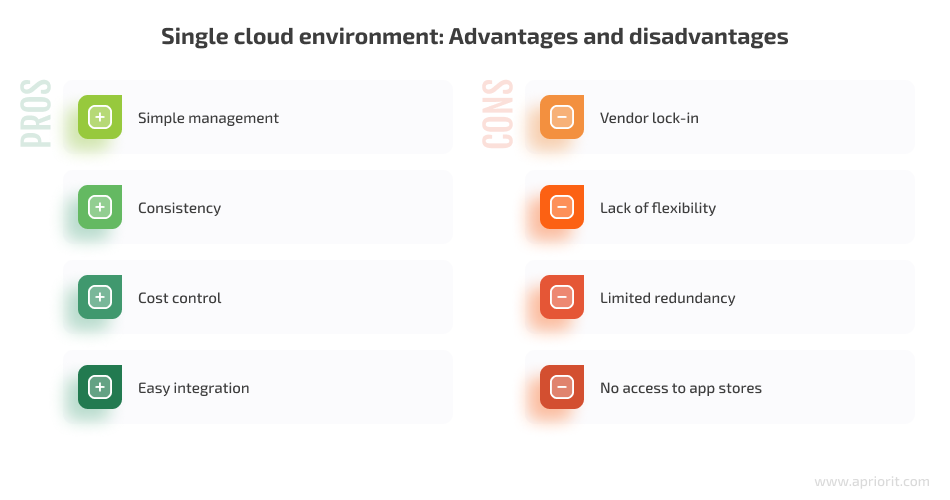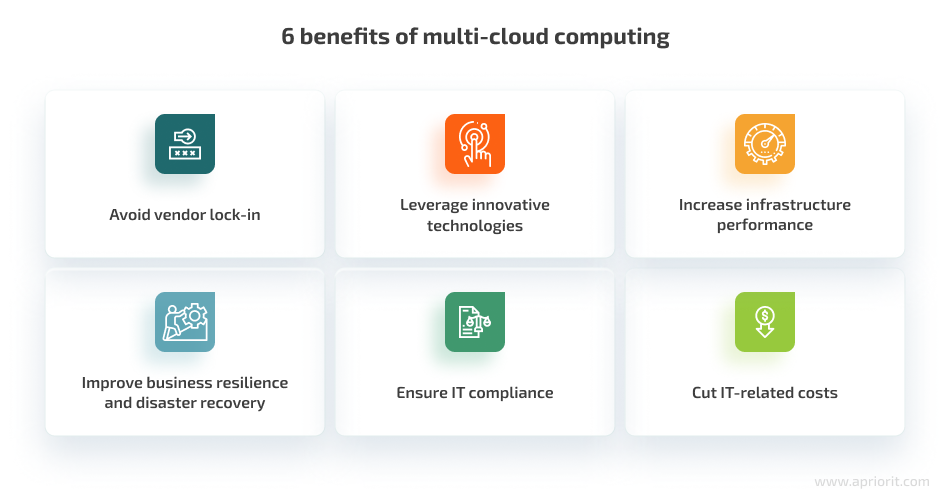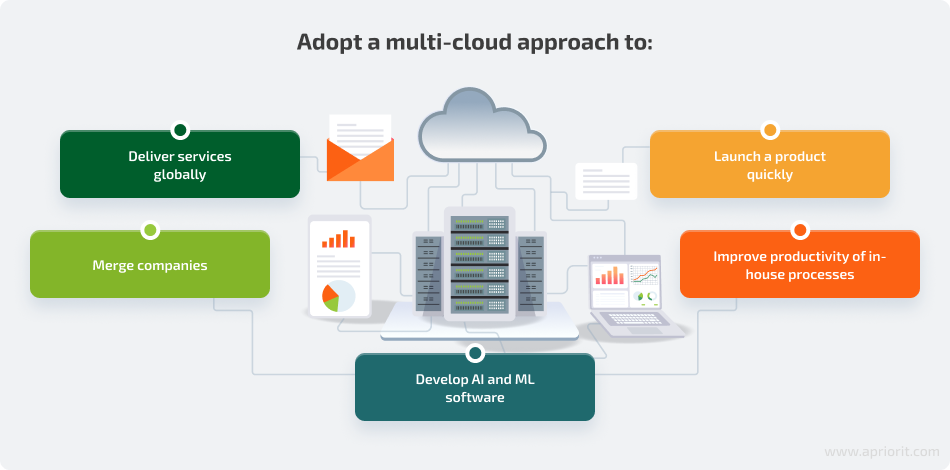Multi-cloud computing is a popular choice for organizations that have already adopted cloud services and don’t want to keep all their eggs in one basket. By selecting cloud services from different providers, you can avoid vendor lock-in, cloud data center outages, and bandwidth issues.
Multi-cloud computing is a popular choice for organizations that have already adopted cloud services and don’t want to keep all their eggs in one basket. By selecting cloud services from different providers, you can avoid vendor lock-in, cloud data center outages, and bandwidth issues.
But this approach isn’t a one-size-fits-all solution. When implemented poorly, a multi-cloud approach can lead to cloud sprawl, security concerns, and complex management procedures. In this article, we examine when it’s best to go with multiple cloud services instead of one, multi-cloud advantages and disadvantages, and best practices to prepare for the adoption of this model.
This post will be useful for development teams that are considering building a multi-cloud environment for their projects.
Contents:
Multi-cloud vs traditional approach to computing
Multi-cloud computing is often defined as a deployment model comprising cloud computing services provided by different vendors. In this article, we’d like to be more precise and follow Gartner’s definition: “the deliberate use of the same type of cloud services from multiple public cloud providers.”
Public and private clouds are two ways of delivering cloud computing services. Public cloud services use shared infrastructure, enabling many customers to access the same service. Customers’ data and activities are still private, but customers operate on the same remote servers. A private cloud service, by contrast, has only one customer. No one except that customer can access the remote server.
The choice between using public and private cloud services depends on an organization’s goal, IT budget, and cybersecurity risks. Most cloud computing vendors allow for combining public and private services. But in this case, you’ll create a hybrid infrastructure that does not share the pros and cons of a multi-cloud strategy.
Almost all organizations have adopted at least one cloud-based service by now. The 2023 IDG Cloud Computing Study found that multi-cloud is the dominant architecture, with 36% of respondents evaluating and nearly a quarter (24%) in the process of deploying this approach.
All types of companies choose multi-cloud computing because of its versatility. It can be combined with multiple Platform as a Service (PaaS), Software as a Service (SaaS), and Infrastructure as a Service (IaaS) solutions.
The most widespread implementation of multi-cloud computing today is a combination of IaaS environments. For example, an enterprise can prefer using Google Cloud Platform for machine learning and Amazon Web Services (AWS) for computing capacity. Using multiple SaaS solutions is the least common option for multi-cloud adoption, but it’s still possible. For example, an organization can use multiple cloud file-sharing services for different data types.
Having said that, multi-cloud isn’t a one-size-fits-all solution. Some organizations can benefit from it, while others may lose more than they gain. Before a multi-cloud architecture became popular, businesses used a single cloud. Let’s look at this traditional alternative and discuss its pros, cons, and appropriate use cases.
Need to build a reliable infrastructure?
Our team of experts can create a reliable and secure infrastructure that can meet any business needs!
Single cloud computing
In the single cloud model, an organization relies on a single third-party vendor for their cloud computing services. This approach is simple and straightforward, as you need to deal with only a single provider and manage data in one place. This allows you to reduce manual administrative tasks and simplify the management process for your organization.
Let’s now look at the benefits and drawbacks of single cloud computing.

The advantages of this approach include:
- Simple management. As you outsource all your applications, functions, data, and workloads to a single provider, you significantly simplify the management process for your enterprise. This can help you save time on management and give your internal team more resources to focus on solving business tasks rather than issues like data migration and synchronization.
- Consistency. It’s easier to maintain a consistent infrastructure and security posture when using a single cloud provider. This is especially important for products that demand compliance with data protection laws.
- Cost control. A single-cloud architecture can make it easier to manage and predict costs as you’re dealing with a single billing structure and pricing model.
- Easy integration. Some cloud providers offer a wide range of services and tools that can be tightly integrated, making it easier to build and deploy applications.
However, the single cloud approach has its downsides too. They include:
- Vendor lock-in. Relying on a single cloud provider can lead to vendor lock-in, making it difficult and costly to migrate to another provider or on-premises infrastructure in the future.
- Lack of flexibility. By choosing a single cloud architecture, you may limit your product to a particular provider’s service offerings. As your product grows and your needs change, this may become a challenge if you want to expand.
- Limited redundancy. In the event of a regional outage or service disruption, a single cloud architecture will not provide the redundancy and failover options of a multi-cloud setup.
- Risk of downtime. If your cloud provider experiences downtime, your entire system may go down, and you won’t have backup systems that can take on the load. This may negatively affect your user satisfaction, reputation, and, consequently, your revenue.
Considering all this, a single cloud architecture is most suitable for:
- Small businesses, startups, and MVPs
- Products with strict regulatory and compliance requirements in industries like healthcare, finance, government
- Low-resource web applications
- Products with limited geographic reach
Let’s now look at what a multi-cloud approach can offer for your business and what benefits it has compared to the single cloud approach.
Benefits of multi-cloud computing
If you introduce multi-cloud computing to a project that needs it and you clearly understand its goal, this deployment model can come with many advantages. Let’s take a look at the key benefits of a multi-cloud strategy:

1. Avoid vendor lock-in. If you use the cloud services of a single vendor, there’s a risk of limited flexibility, data loss, or service downtime because of the vendor’s local circumstances. You also become dependent on that vendor’s services and prices since migrating the whole infrastructure from one cloud to another is challenging. A multi-cloud approach allows you to have a backup on another cloud service provider and be able to change vendors more easily.
2. Leverage innovative technologies. When building a multi-cloud environment, you can choose the most innovative vendors in each field. Major cloud service providers can save you time studying and developing certain high-tech features like machine learning and artificial intelligence, blockchain, etc. You also can quickly change one or several cloud vendors if you discover a newer or better-fitting technology.
3. Increase infrastructure performance. Using high-speed resources located in different regions helps organizations achieve maximum infrastructure and bandwidth performance. Choosing several IaaS providers in several regions also allows you to improve the local user experience and balance the cost of infrastructure support with efficiency.
4. Improve business resilience and disaster recovery. Even the biggest and most reliable cloud service providers can have outages and downtime. When locked into a single vendor, an organization can’t do anything when that vendor experiences issues. Having several cloud providers enables an organization to switch to a backup cloud when their main vendor goes down.
5. Ensure IT compliance. Many countries have strict data handling requirements. One common requirement is that private data shouldn’t be stored abroad. However, not all cloud vendors have a data center in a particular country or region. By using the services of different cloud vendors that have servers in particular locations, companies can ensure ITAR and GDPR compliant app development.
6. Cut IT-related costs. The ability to choose suitable vendors both in terms of service quality and price helps you build the best possible infrastructure within your budget. You can also significantly reduce the cloud costs for your organization by using more affordable services from different cloud vendors.
Now, let’s see in which cases multi-cloud computing is the better choice.
When is it best to adopt a multi-cloud strategy?
You can benefit from multi-cloud strategy if you need to:

1. Deliver services globally. It’s challenging to provide quality services to clients all around the world when your infrastructure is hosted on-premises. Using only one cloud provider is also not an option since the farther your clients are from the provider’s servers, the slower their connection. Using multiple cloud providers allows international organizations to acquire servers in regions close to their clients, ensuring an equally fast and stable connection for all clients.
2. Launch a product quickly. Time to market is an essential factor of a product’s success. A quick launch helps companies stand out among competitors and attract more clients. The multi-cloud model provides quick access to all the services an organization needs. That’s why organizations that want their products up and running fast usually choose the most suitable services from various cloud providers. Building a multi-cloud environment can save you time compared to designing and configuring a homogeneous or hybrid infrastructure.
3. Merge companies. Mergers and acquisitions often require IT teams to figure out a way to combine two completely different environments. In cases when the companies that are being merged use different cloud providers, the simplest solution is to create a multi-cloud environment rather than completely rework the IT infrastructure.
4. Improve productivity of in-house processes. Satisfying the needs of a large organization with services from a single cloud provider isn’t always possible. For example, a product development company can deploy its key product with IBM Cloud, which provides many configuration and management options, and use more straightforward services with preconfigured deployment options for a simpler and smaller pilot project. In this case, combining two cloud services is more convenient than looking for a compromise that meets all of the organization’s needs.
5. Develop artificial intelligence (AI) and machine learning (ML) software. The biggest cloud service providers like IBM Cloud, AWS, and Microsoft Azure offer specific products, datasets, and dedicated hardware for AI development. Using them instead of creating an AI development environment from scratch helps organizations efficiently configure and train their algorithms.
Want to learn more about developing AI- and ML-based software? Check out our article on starting new AI projects and things you need to consider to make your project sustainable and successful.
Despite all the multi-cloud computing benefits, adopting this model may result in more losses than gains for some organizations. To avoid them, you need to know about important aspects of the model and prepare your organization for them. Let’s take a look at key aspects to keep in mind.
Related project
Building AWS-based Blockchain Infrastructure for International Banking
Explore how Apriort helped a blockchain development company build an AWS-based blockchain infrastructure for their smart contracts.

What to consider before multi-cloud adoption
According to the IDG Cloud Computing Study, 79% of organizations reported experiencing challenges of multi-cloud adoption in 2020. Some can be prevented with a well-thought-through multi-cloud implementation, but some are inherent to this model. Here are the key issues you can experience:

1. Management complexity. The more cloud vendors you work with, the more resources your IT team has to manage. Most vendors have their own technologies, interfaces, services, and languages. There’s little to no standardization across cloud-based services, so each service you use will likely require a unique management approach. If left unmanaged, your multiple clouds can cause cloud sprawl and the growth of shadow IT.
2. Need for cloud management expertise. When enterprises decide to adopt multi-cloud computing, they usually don’t have a dedicated DevOps team and in-house experts in application deployment and management in several cloud services. Lack of expertise either limits an organization’s choice of cloud platforms to those that are familiar or makes the organization search for outsourced cloud management experts.
3. Cost overhead. Though the cloud model is considered to be cost-saving for enterprises, it adds complexity to controlling cloud spending. Enterprises now have to constantly compare prices for cloud services and keep a close eye on their current cloud expenses. Additionally, they have to reconsider their need for certain cloud services to avoid cloud sprawl.
4. Performance inconsistencies. The performance of shared infrastructure depends on its server load and the number of users interacting with the service. That’s why going with smaller cloud vendors with limited computing power may harm the performance of your products.
5. Security concerns. Regardless of your approach to cloud architecture, multi-cloud and single cloud strategies share similar security challenges, including sharing responsibility for data protection with a cloud provider.
Although most vendors offer built-in cybersecurity tools to protect customers’ data, cloud adoption outpaces the implementation of robust security policies. Working with multiple cloud services creates additional security risks like:
- Inconsistent cybersecurity protocols. Different cloud providers use different tools and policies to ensure data security. This can create confusion and inconsistencies when you share data across multiple providers.
- Inconsistent access policies. Your employees will need access credentials to multiple clouds, and it may become challenging to maintain consistent role-based access policies across your organization.
- Inconsistent updates. Each cloud provider regularly updates their software to eliminate vulnerabilities and improve their service. You need to track all these updates and manage them on time to prevent cybersecurity gaps.
Thus, you need a multi-layered security approach when working with several cloud hosting environments. It’s also a good idea to carefully monitor your cloud resources and cooperate only with trusted cybersecurity partners.
While some of these multi-cloud characteristics may be unavoidable, you can mitigate their effects on your organization by carefully planning the adoption of a multi-cloud model. In the next section, we share several best practices to get the most out of multi-cloud adoption.
How to prepare for multi-cloud adoption
Experiencing all the advantages of the multi-cloud model while tackling its challenges isn’t an easy job. At Apriorit, we have developed best practices to ensure our clients’ heterogeneous infrastructures run smoothly:

1. Create a multi-cloud strategy. The first step we take at Apriorit is creating a deliberate strategy for adopting multi-cloud computing. This step may make the adoption process longer but will save you lots of time and effort in managing your infrastructure in the future. Usually, a multi-cloud strategy defines the following:
- Migration plans to transfer data from the current environment to multiple cloud environments
- A list of cloud service providers that best suit your business needs and goals
- A list of strategic cloud providers and services, along with possible alternatives
- Tiers of support and management that your cloud services require
- Technology stack, languages, management tools, policies, and practices you want to maintain across all of your cloud services
- Design of intercloud data exchange processes
- Risks of data concentration, vendor lock-in, and performance decreases for each cloud vendor
2. Build a DevOps pipeline. An enterprise’s integration with multiple cloud services puts additional pressure on the IT department. To cope with this pressure, we recommend building an efficient DevOps pipeline. DevOps activities should be agile and scalable to ensure continuous integration and continuous releases within the heterogeneous environment. DevOps engineers also require access to platforms and tools specially designed for working in multi-cloud environments. By taking these issues into account, you can efficiently build cloud-specific automation in a DevOps pipeline.
3. Unify the toolchain. Because there’s no standardization among cloud providers, we always take time to unify a toolchain to make it compatible with as many cloud services as possible. For example, it’s best to ensure you use cloud storage that’s compatible with Amazon S3 or use Docker if you want to deal with containers. This approach will help you smoothly run your heterogeneous environment and ensure easy workload migration across different clouds.
4. Monitor infrastructure performance. Cloud vendors offer their own monitoring tools, but for a heterogeneous environment, we recommend implementing additional monitoring. It’s necessary for you to see the whole picture across different clouds. For this purpose, you can use commercial products developed with multi-cloud environments in mind or use open-source monitoring tools like Zabbix, Ganglia, or Nagios.
5. Enforce cybersecurity mechanisms. Adopting multi-cloud computing creates more entry points and vulnerabilities that can lead to a security incident. While many cloud service providers offer built-in data protection tools, organizations have to ensure their data is solidly protected. To do that, you can use the following tools and practices:
- Introduce robust access management and authentication procedures
- Manage any cloud-related secrets securely
- Establish secure data-sharing procedures
- Back up cloud data periodically
- Audit your multi-cloud environment to discover new vulnerabilities, shadow IT, account creep, etc.
- Keep a changelog of user activities
6. Build long-term relationships with strategic vendors. Organizations that adopt a multi-cloud strategy usually have one or two key vendors that host most of their activities. Make sure to frequently communicate with your strategic vendors, provide them feedback, and suggest new features. Most vendors are open to client suggestions and will try to make their services more convenient for you.
Conclusion
Multi-cloud computing offers many advantages for enterprises and allows them to meet their current business needs, including IT budget optimization, access to best-in-breed services and technologies, and improved disaster recovery. However, not all organizations need to experience the benefits and advantages of multi-cloud computing.
Developing a multi-cloud environment and strategy that meets your business needs and mitigates cloud-related risks takes a lot of experience and expertise. That’s why many organizations outsource cloud infrastructure management activities instead of building an in-house team. Apriorit is ready to help you build a solid solution and ensure multi-cloud security within your projects.
Need to build a reliable infrastructure?
Leverage Apriorit engineers’ expertise to get a scalable infrastructure that reflects your business needs!



